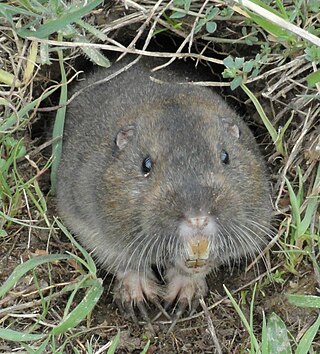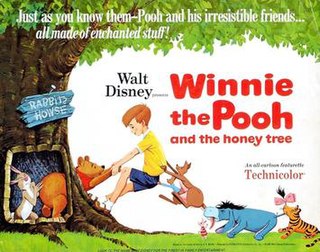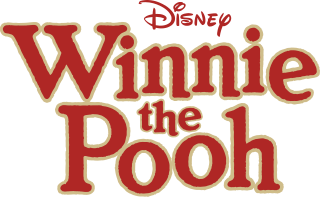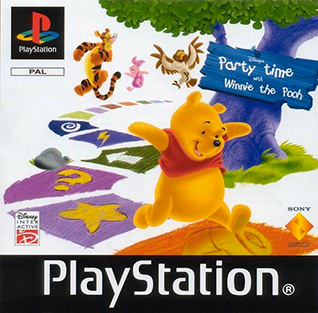A gopher , also known as a "pocket gopher" (family Geomyidae), is a burrowing rodent native to North America and Central America.
Contents
Gopher may also refer to:
A gopher , also known as a "pocket gopher" (family Geomyidae), is a burrowing rodent native to North America and Central America.
Gopher may also refer to:
Piglet may refer to:

Tigger is a fictional character, an anthropomorphic stuffed tiger. He was originally introduced in the 1928 story collection The House at Pooh Corner, the sequel to the 1926 book Winnie-the-Pooh by A. A. Milne. Like other Pooh characters, Tigger is based on one of Christopher Robin Milne's stuffed toy animals. He appears in the Disney animated versions of Winnie the Pooh and has also appeared in his own film, The Tigger Movie (2000).
The New Adventures of Winnie the Pooh is an American animated television series produced by Walt Disney Television Animation. Based on the Winnie-the-Pooh books by authors A. A. Milne and E. H. Shepard, The New Adventures was the first time a major Disney character headlined an animated, made-for-television series as well as the first Disney television series based on a major animated film. The cartoon premiered with a limited run on The Disney Channel on January 17, 1988. Nine months later, the show moved to ABC as part of their Saturday morning lineup. New episodes continued until October 26, 1991. Proving popular with children and older fans, it remained on television in the United States for nearly two decades.
A rabbit is a mammal.

The Many Adventures of Winnie the Pooh is a 1977 American animated musical anthology comedy film produced by Walt Disney Productions and distributed by Buena Vista Distribution. It is the 22nd Disney animated feature film and was first released on a double bill with The Littlest Horse Thieves on March 11, 1977.
Winnie or Winny may refer to:

The Hundred Acre Wood is a part of the fictional land inhabited by Winnie-the-Pooh and his friends in the Winnie-the-Pooh series of children's stories by author A. A. Milne. The wood is visited regularly by the young boy Christopher Robin, who accompanies Pooh and company on their many adventures.
A gofer, go-fer or gopher is an employee who specializes in the delivery of special items to their superior(s). Examples of these special items include a cup of coffee, a tool, a tailored suit, or a car. Outside of the business world, the term is used to describe a child or young adult who is learning how to do tasks and is sent to fetch items. A similar job is that of peon in Commonwealth countries.

Pocket gophers, commonly referred to simply as gophers, are burrowing rodents of the family Geomyidae. The roughly 41 species are all endemic to North and Central America. They are commonly known for their extensive tunneling activities and their ability to destroy farms and gardens.

Winnie the Pooh and the Honey Tree is a 1966 American animated featurette based on the first two chapters of Winnie-the-Pooh by A. A. Milne. The film was produced by Walt Disney Productions, and released by Buena Vista Distribution on February 4, 1966, as a double feature with The Ugly Dachshund. It was the last short film produced by Walt Disney, who died of lung cancer on December 15, 1966, ten months after its release. Its songs were written by the Sherman Brothers and the score was composed and conducted by Buddy Baker.

Winnie the Pooh and the Blustery Day is a 1968 American animated featurette based on the third, fifth, ninth, and tenth chapters of Winnie-the-Pooh and the second, eighth, and ninth chapters from The House at Pooh Corner by A. A. Milne. The featurette was directed by Wolfgang Reitherman, produced by Walt Disney Productions and released by Buena Vista Distribution Company on December 20, 1968, as a double feature with the live-action comedy feature The Horse in the Gray Flannel Suit. This was the second of the studio's Winnie the Pooh theatrical featurettes. It was later added as a segment to the 1977 film The Many Adventures of Winnie the Pooh. The music was written by Richard M. Sherman and Robert B. Sherman. It was notable for being the last Disney animated short to be produced by Walt Disney, who died of lung cancer on December 15, 1966, two years before its release.

Gopher is a fictional grey anthropomorphic gopher character who first appeared in the 1966 Disney animated film Winnie the Pooh and the Honey Tree. He has a habit of whistling out his sibilant consonants, one of various traits he has in common with the beaver in Lady and the Tramp, by whom he may have been inspired. While he never made appearances in any episodes of Welcome to Pooh Corner, Gopher was fleshed out a bit further in the television series The New Adventures of Winnie the Pooh. He is portrayed as generally hard-working, especially in his tunnels. He does not appear in the original books Winnie-the-Pooh and The House at Pooh Corner by A. A. Milne. Gopher's voice was originally done by Howard Morris, who retired from the role and was replaced by Michael Gough.

Winnie the Pooh is a fictional bear and the main character in Disney's Winnie the Pooh franchise, based on the character Winnie-the-Pooh created by English author A. A. Milne and English artist and book illustrator E. H. Shepard, being one of the most popular characters adapted for film and television by The Walt Disney Company. Disney first received certain licensing rights to the Winnie-the-Pooh stories, characters, and trademarks from Stephen Slesinger, Inc. and the estate of A. A. Milne in 1961.

Winnie the Pooh and Christmas Too is a 1991 Christmas television special based on the Disney television series The New Adventures of Winnie the Pooh, originally broadcast on December 14, 1991, on ABC and produced by Walt Disney Animation (France), S.A. and Walt Disney Television Animation.

Ready to Read with Pooh is a 1997 interactive CD-ROM video game developed by Disney Interactive's Victoria studio that helps children from ages three to six, learn to read. There are nine activities in the game. When the player completes an activity successfully, they will receive an item that goes into a treehouse. A companion game Ready for Math with Pooh, which focused on math skills and has a garden and seven activities, was also released around the same time as this game.
Winnie-the-Pooh is a fictional teddy bear, and the central character in the book series by A. A. Milne.

Winnie-the-Pooh is a fictional anthropomorphic teddy bear created by English author A. A. Milne and English illustrator E. H. Shepard. Winnie-the-Pooh first appeared by name in a children's story commissioned by London's Evening News for Christmas Eve 1925. The character is based on a stuffed toy that Milne had bought for his son Christopher Robin in Harrods department store.

Winnie the Pooh is a media franchise produced by The Walt Disney Company, based on A. A. Milne and E. H. Shepard's stories featuring Winnie-the-Pooh. It started in 1966 with the theatrical release of the short Winnie the Pooh and the Honey Tree.

Party Time with Winnie the Pooh is a Party video game released for the PlayStation in 2001. It was developed by Doki Denki Studio and published by Electronic Arts in the United States and Sony Computer Entertainment Europe in Europe.